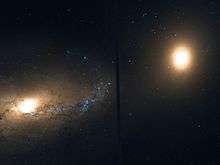NGC 3227
| NGC 3227 | |
|---|---|
|
NGC 3227 and NGC 3226 | |
| Observation data (J2000 epoch) | |
| Constellation | Leo |
| Right ascension | 10h 23m 30.6s[1] |
| Declination | +19° 51′ 54″[1] |
| Redshift | 1157 ± 3 km/s[1] |
| Distance | 77 ± 9 Mly (24 ± 3 Mpc)[2] |
| Apparent magnitude (V) | 11.1[1] |
| Characteristics | |
| Type | SAB(s) pec[1] |
| Apparent size (V) | 5′.4 × 3′.6[1] |
| Other designations | |
| UGC 5620,[1] PGC 30445,[1] Arp 94[1] | |
NGC 3227 is an intermediate spiral galaxy that is interacting with the dwarf elliptical galaxy NGC 3226. The two galaxies are one of several examples of a spiral with a dwarf elliptical companion that are listed in the Atlas of Peculiar Galaxies.[3] Both galaxies may be found in the constellation Leo.
Sir William Herschel already recognised them as a 'double nebula' and they were jointly listed as Holm 187 in the Catalogue of Double and Multiple Galaxies and as Arp 94 in the Atlas of Peculiar Galaxies. Amateur telescopes can discern them but require magnification of about 100 times. They are situated 50′ east of the well-known double star system Gamma Leonis (i.e. Algieba).
Nucleus
NGC 3227 contains a Seyfert nucleus, a type of active galactic nucleus (AGN).[4] Such Seyfert nuclei typically contain supermassive black holes.
As is typical of many AGN, the nucleus of NGC 3227 has been identified as a source of variable X-ray emission.[5][6][7][8][9] This variability occurs on time scales ranging from a few hours to a few months.[5][7][8][9] The variability may be caused by variations in the density or ionization of gas and dust near the AGN that absorb the X-ray emission.[6][7][8][9] A substantial amount of the X-ray-absorbing gas may lie within 0.4 parsec (1.3 light-years) of the nucleus.[9] An observed change in the shape of the X-ray spectrum in 2000 and 2001 suggests that some of the X-ray absorbing gas is located within 10–100 light-days of the nucleus.[10]
The luminosity of the nucleus reached a maximum in 1977 when evidence suggesting long-lived one-sided or two-sided gas streams was obtained. X-ray radiation of the central accretion disc is reprocessed in one to two days to be re-emitted in the optical spectrum. Infra-red light emission from the hot dust torus lags optical light emission from the nucleus by about 20 days in NGC 3227. The temperature of the dust torus is estimated at 1500 K to 1800 K in NGC 3227 and similar galaxies.
This galaxy was studied by the Multicolor Active Galactic Nuclei Monitoring 2m telescope.[11]
References
Coordinates: ![]() 10h 23m 30.6s, +19° 51′ 54″
10h 23m 30.6s, +19° 51′ 54″
- Catalogue of Double and Multiple Galaxies, Erik Holmberg, 1937
- A catalogue of dwarf galaxy candidates around interacting galaxies, Astron. Astrophys., Suppl. Ser., 129, 455-462 (1998) - May(I) 1998, Deeg, H.J. et al.
- Long-term variability of the optical emission lines in the nuclear spectrum of the Seyfert galaxy NGC 3227, Active Galaxies Newsletter, No 98, Pronik I., Metik L., May 2005
- Reverberation Measurements of the Inner Radius of the Dust Torus in Nearby Seyfert 1 Galaxies, M. Suganuma et al., Astrophysical Journal, vol 639, March 2006
- 1 2 3 4 5 6 7 8 9 "NASA/IPAC Extragalactic Database". Results for NGC 3227. Retrieved 2006-10-12.
- ↑ J. L. Tonry; A. Dressler; J. P. Blakeslee; E. A. Ajhar; et al. (2001). "The SBF Survey of Galaxy Distances. IV. SBF Magnitudes, Colors, and Distances". Astrophysical Journal. 546 (2): 681–693. arXiv:astro-ph/0011223
 . Bibcode:2001ApJ...546..681T. doi:10.1086/318301.
. Bibcode:2001ApJ...546..681T. doi:10.1086/318301. - ↑ H. Arp (1966). "Atlas of Peculiar Galaxies". Astrophysical Journal Supplement. 14: 1–20. Bibcode:1966ApJS...14....1A. doi:10.1086/190147.
- ↑ L. C. Ho; A. V. Filippenko; W. L. W. Sargent (1997). "A Search for "Dwarf" Seyfert Nuclei. III. Spectroscopic Parameters and Properties of the Host Galaxies". Astrophysical Journal Supplement. 112 (2): 315–390. arXiv:astro-ph/9704107
 . Bibcode:1997ApJS..112..315H. doi:10.1086/313041.
. Bibcode:1997ApJS..112..315H. doi:10.1086/313041. - 1 2 A. F. Tennant; R. F. Mushotzky (1983). "The absence of rapid X-ray variability in active galaxies". Astrophysical Journal. 264: 92–104. Bibcode:1983ApJ...264...92T. doi:10.1086/160576.
- 1 2 T. J. Turner; K. A. Pounds (1989). "The EXOSAT spectral survey of AGN". Monthly Notices of the Royal Astronomical Society. 240: 833–880. Bibcode:1989MNRAS.240..833T. doi:10.1093/mnras/240.4.833.
- 1 2 3 A. Ptak; T. Yaqoob; P. J. Serlemitsos; R. Mushotzky; et al. (1994). "Rapid X-ray spectral variability in NGC 3227". Astrophysical Journal. 436: L31–L34. Bibcode:1994ApJ...436L..31P. doi:10.1086/187626.
- 1 2 3 S. Komossa; H. Fink (1997). "Evidence for a dusty warm absorber in NGC 3227?". Astronomy and Astrophysics. 327: 483–492. arXiv:astro-ph/9707003
 . Bibcode:1997A&A...327..483K.
. Bibcode:1997A&A...327..483K. - 1 2 3 4 P. Gondoin; A. Orr; D. Lumb; H. Siddiqui (2003). "XMM-Newton observations of the Seyfert 1 galaxy NGC 3227". Astronomy and Astrophysics. 397 (3): 883–890. Bibcode:2003A&A...397..883G. doi:10.1051/0004-6361:20021574.
- ↑ G. Lamer; P. Uttley; I. M. McHardy (2003). "An absorption event in the X-ray light curve of NGC 3227". Monthly Notices of the Royal Astronomical Society. 342 (3): L41–L45. arXiv:astro-ph/0305130
 . Bibcode:2003MNRAS.342L..41L. doi:10.1046/j.1365-8711.2003.06759.x.
. Bibcode:2003MNRAS.342L..41L. doi:10.1046/j.1365-8711.2003.06759.x. - ↑ http://www.journals.uchicago.edu/doi/abs/10.1086/499326 The Astrophysical Journal, 639:46–63, 2006 March 1 "Reverberation Measurements of the Inner Radius of the Dust Torus in Nearby Seyfert 1 Galaxies"
External links
- Glen Youman's Astrophotos of NGC 3226 and NGC 3227
- Cosmic Voyages webpage on NGC 3226 and NGC 3227
- Spitzer observations of the interacting galaxy pair
- Long-term variability of the optical emission lines in the nuclear spectrum of the Seyfert galaxy NGC 3227, Pronik et al., Active Galaxies Newsletter, No. 98
- Reverberation Measurements of the Inner Radius of the Dust Torus in Nearby Seyfert 1 Galaxies, Suganuma et al., ApJ, March 2006, vol. 639
- NGC 3227 on WikiSky: DSS2, SDSS, GALEX, IRAS, Hydrogen α, X-Ray, Astrophoto, Sky Map, Articles and images
